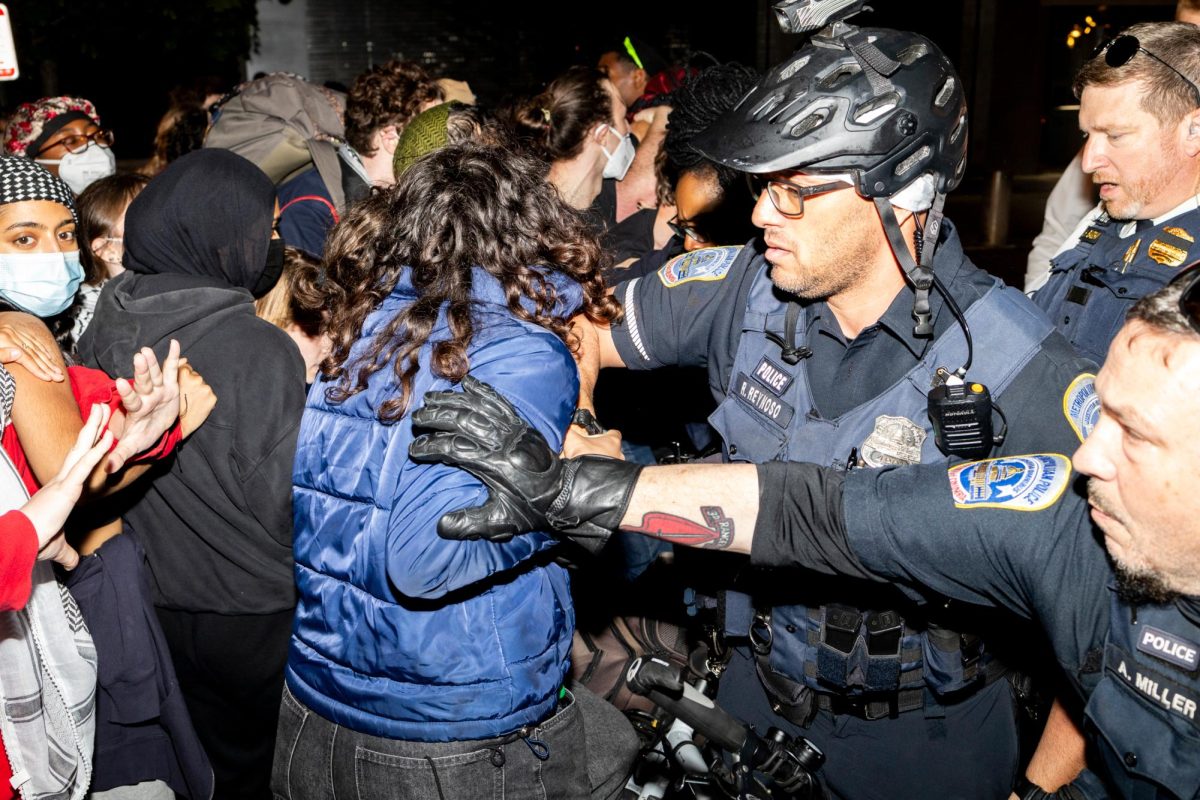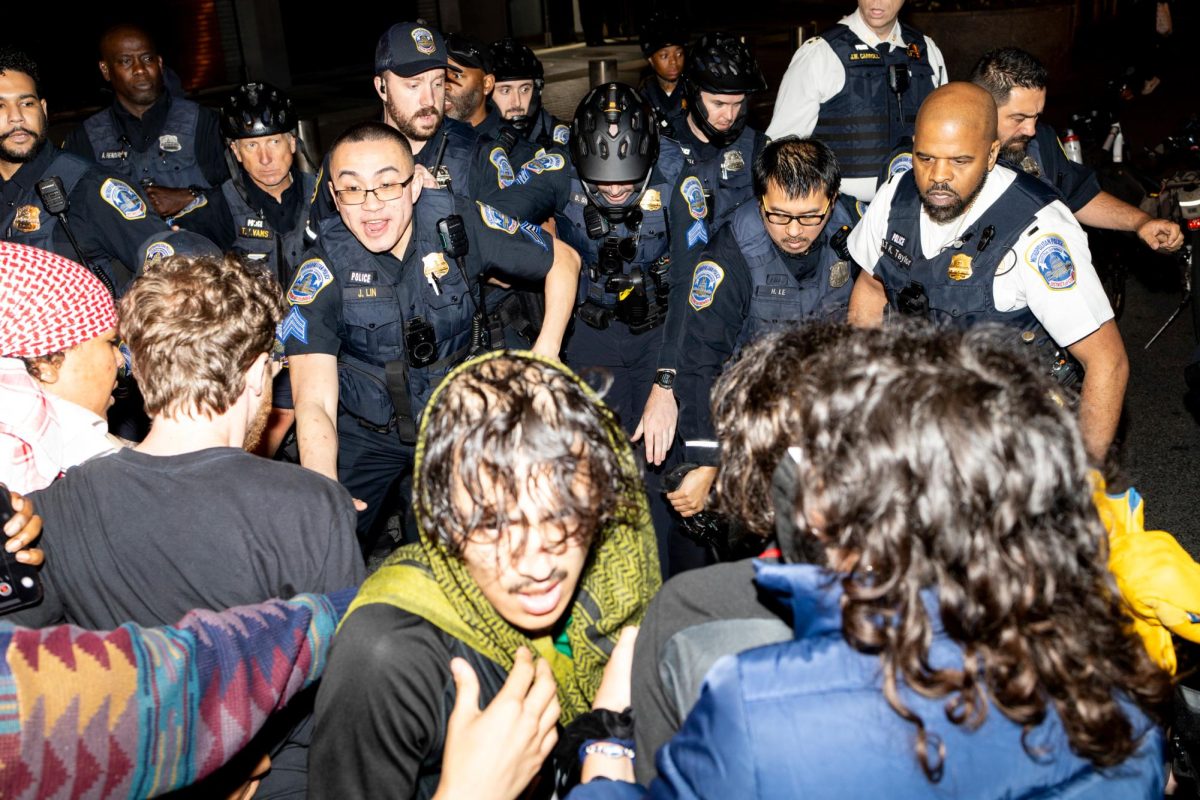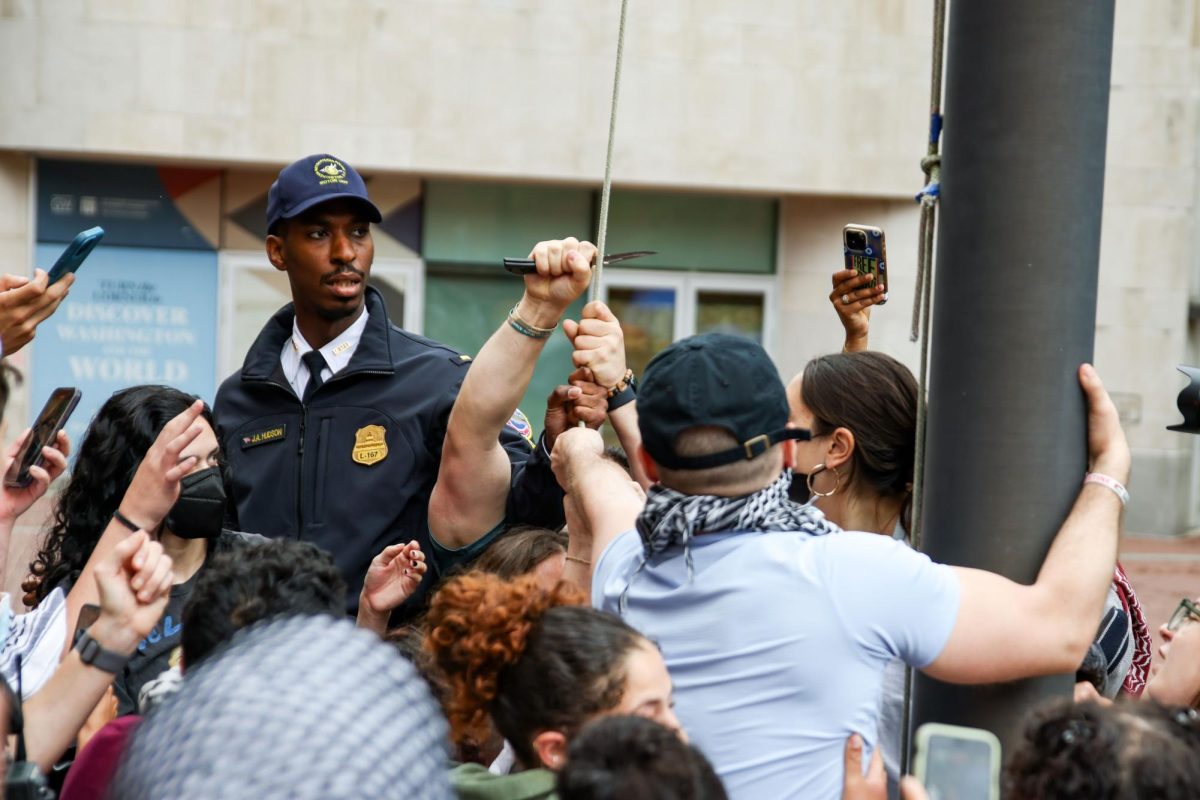As the members of the GW men’s basketball team walked onto the court in the second half of Saturday’s game against Xavier, about 5,000 screaming fans were behind them. And as they came back to win after a 15-point deficit at halftime, GW Coach Tom Penders knew whom to thank.
Walking toward the scorer’s table as the band blared the GW Fight Song, Penders grabbed the microphone.
The `Smith Center psychos’ are the best, he declared.
It used to be when brochures reached prospective students’ doorsteps during their junior years of high school, it was the first time they heard of GW. Now, three things have changed the way students hear about GW – an orange ball, a wooden court and millions of dollars in expenses.
This deliberate strategy has worked. GW, while not yet a basketball powerhouse, has gotten its share of airtime on national television. High school students are learning the names of the players and the institution through the rise of its athletic program. And as the University becomes more synonymous with athletics, the school benefits both locally and worldwide.
A new game plan
When Robert Chernak, vice president of Student and Academic Support Services, joined the University 12 years ago, along with new University President Stephen Joel Trachtenberg, he saw a school that was wasting its money. The University had an athletic program and was paying for scholarships, salaries, travel and facilities, yet it was not reaping the benefits of a good program.
During the 1988-89 basketball season, the men’s team had only one win and 27 losses. You don’t get much exposure with one win. No one wants to write newspaper stories about you, and cable sports channels don’t want to show your games to a regional or national audience.
Four years later, the men’s team bolted into the Sweet 16 of the NCAA Tournament, and basketball fans around the world met the Colonials.
Three years later, when GW beat the number-one ranked University of Massachusetts, it once again gained a national spotlight. And with a women’s basketball program that has been consistently good during the last decade, suddenly GW – the basketball teams, and along with it, the University – became a recognized name.
You couldn’t afford to buy all that advertising, Chernak said.
Creating a successful basketball program, both for men and women, is a type of marketing strategy many institutions have been using. As schools increase their basketball expenses and improve their programs, national exposure follows.
When you are successful, you have an opportunity to get more column inches in the newspaper and have GW in two-and-a-half hours of air time, Chernak said. You increase very dramatically the name recognition for the institution.
The implementation of the plan benefits several different aspects of the University. Alumni and students have something tangible of which they can be proud, and prospective students are learning about the school without even knowing it.
But all this free publicity is expensive. To get a better basketball team, you need better coaches who demand bigger contracts. To get the best players, you need to travel nationwide – and in GW’s case, worldwide.
GW spends almost $900,000 a year in scholarships for the male and female basketball players, close to a quarter of all athletic scholarship money the school doles out, Chernak said. And the Colonial basketball teams create $1.2 million in other expenses, including coaches’ salaries, travel, operations and recruitment expenses.
But University officials say it is money well spent and see the tangible results a successful athletic program has on the educational environment of the University.
Landing blue chips
GW always has been interested in finding the best recruits, both for academic programs and for the University. And in a decade of successful basketball programs, the University worked hard to improve other facets of college life. That effort has led to great strides in admissions and enrollment numbers, numbers administrators, including those in the athletic department, wear as a badge of honor.
I would like to believe that the growth in admission is helped on some degree by our intercollegiate athletic program and its successes, Athletic Director Jack Kvancz said.
In 1988, less than 6,000 students applied for undergraduate study at GW. Last year, that number reached 14,200.
If you say you want GW to be among the elite institutions in the country, and you see who the elite institutions are, you’ll see that they excel in a lot of things, including athletics, Chernak said.
He said basketball is one of the normative elements of a University, and a successful team has become a litmus test for many students, not just athletes.
People generally want to be affiliated with an organization that enhances their own esteem, Chernak said. You don’t want to be affiliated with an organization that is perceived as a loser.
He said having a sports program, but not excelling at it, is counter-productive to helping the admissions game.
Student and athlete
Once students get to Foggy Bottom, the yearning for their affection does not end. These games have lured many students to campus, and the players and coaches feel they have an obligation to give them what they want – victories.
I think we can offer the students basically the chance to watch a national program and support their fellow students, said Joe McKeown, head coach of the women’s basketball team.
Chernak said unlike many basketball programs, the proximity of the players to the other students is an attraction for both the athletes and their peers.
I think at GW.the student athletes are very interwoven into the fabric of campus life, Chernak said.
The basketball program has been able to recruit international basketball stars because of the school’s location in Washington and the existence of many national embassies.
Tom Penders, who took over as men’s basketball head coach last year, has just begun to recruit players at GW. He said he does not see another school that compares for players who want an urban campus and a good education.
Every recruited basketball player today thinks he’s going to play in the NBA, Penders said. And all I talk about is the MBA.
The close quarters of the University and the demanding academic requirements attract a specific type of athlete, Kvancz said.
We’re trying to have a successful program that alumni and students will be proud of, he said. And we’re trying to do it with kids that get that the degree is the most important thing we have to offer.
SirValiant Brown, a freshman on the men’s basketball team, said his fellow students don’t realize the emphasis placed on education within GW athletics.
Everyone thinks basketball players have it all gravy, but that’s not the case, Brown said. Basketball players have to work even harder.
He said the dual commitments to athletics and education mean studying on plane rides and making up work with tutors.
While other people may look at the banners in the Smith Center as a sign of success, Ed Caress, associate dean of the Columbian School of Arts and Sciences, looks at GW’s graduation rate among athletes, which is higher than the student population as a whole. Caress has served since the 1970s as GW’s faculty representative to the NCAA.
He said student athletes have to realize that the rate of making it into the professional leagues is so low, they need to focus on education. Caress said he does not believe the special effort given to educating the athletes is unfair.
It would be nice to be able to provide the same kind of support to all the students at the University, he said. But we are asking this group of kids to participate in intercollegiate sports, which means they have to give up time for studying.
To provide some extra help, because we are demanding so much from them, is not unreasonable to do, Caress said.
Kvancz said in exchange for their extra effort, student athletes are learnin
g something not taught in the classroom.
Probably the greatest thing it does for the kids who participate is there is nothing you can’t do if a group puts their mind together and determine to get it done, Kvancz said.
Viscous cycle
To get the good basketball players, the so-called blue chips, you need a program that has proven its success. And, of course, to have a program prove its success, you need the good players.
This viscous cycle has been seen at schools nationwide. The battle for the blue-chip players has become a national one, as schools have received suspensions for violating recruitment restrictions and for sneaking in players below the NCAA college eligibility requirements.
All of the GW administrators emphasize that doing it right is paramount in their minds. But recruiting a top program from scratch is not always easy when following the rules.
Generally speaking, we are not going to be quite at that level with the known stars in high school, Chernak said. We will be engaged with the kids right below that.
Kvancz said McKeown is able to land blue-chip players for his women’s program. But until the team becomes a powerhouse, or moves into a more competitive and more visual conference, the men will be in the running for, but have trouble landing, those blue-chip players.
The rich get richer, Kvancz said. You can only spend so many days on the road. The teams that have the most exposure get the leg up.
The problems associated with recruiting college basketball players have been most often associated with the men’s teams. But McKeown sees the problems on the horizon, if they are not already there, for the women’s programs with the rise of the WNBA.
You’re going to see women leaving early to go into the pros, McKeown said. I’m not sure there’s a way to prevent it.
But he said there will be no recruiting violations in his camp.
If I have to cheat to get players, I’m going to find another way to make a living, he said.
Currently, GW is not facing problems of other schools. It simply does not have a basketball program on that level yet. But it may not need to be.
The men’s and women’s basketball programs account for 85 percent of the revenue GW receives from athletic programs, helping to subsidize much of the cost. That doesn’t take into account all the money brought in to the University through alumni and outside donors because of the school’s increased name recognition. And with the University breaking into U.S. News and World Report‘s Top 50, GW has made it onto the map.
It’s all a game when all is said and done, Chernak said. There’s only one team that wins a championship.
You’re not in it to be the champion, he said. You’re in it to achieve smaller goals, and that is to make things normal. If GW didn’t have basketball, I don’t think it would be a normal institution.







